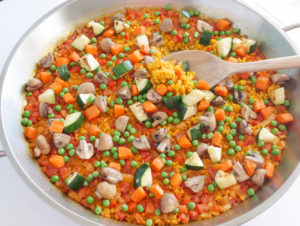
free of gluten and top 8 allergens
Really good paella has an amazing taste and texture. Named after the cooking pan itself, every Spanish family has its own recipe of this dish.
We just got back from Barcelona, where we dug deep into finding the secrets to making the best paella. Join us as we share our take on Spain’s most popular dish.
Peas?
Well, there are a couple of golden rules about paella, at least that’s what we were told. True Valencian paella is made with rabbit, chicken and green beans in summer, duck and artichoke in winter. There also should be no garlic…no peas…no potatoes…no stock…and no chorizo. Seafood and meat should never be mixed and seafood paella is only made if by the sea.
Whew! We sure did break the rules on peas and stock. I tried talking Joel out of the peas, but he dearly loves them. Besides, I couldn’t find nice fresh green beans this week.
On this trip to Barcelona, our favorite paella was from Restaurant Gaudim. We wanted you to see an authentic Spanish paella before we started making ours. Check out how thin the layer of rice is…
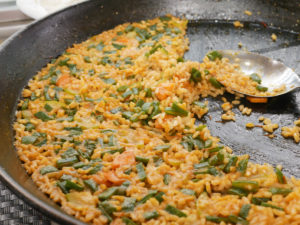
Vegetable Paella from Restaurant Gaudim in Barcelona, Spain
Absolutely delicious!
Once you have the techniques down, the adaptations are endless. Paella is a great way to use up seasonal vegetables that you may have onhand. Improvisation is the name of the game, since even in Spain the issue of what ingredients should go in paella is fiercely disputed.
That being said, there are still some guidelines.
The Rice
The short, round grains (Spanish rice) are perfect for paella and absorb liquid really well, which makes it the ideal rice for paella.
Rice varieties that are suitable for paella like Bomba (the most popular), Senia, and Calasparra are readily available in Spain. We brought back plenty of sacks of bomba rice, which are often packaged in cloth sacks which allow the rice to breath and maintain its high quality. However, if you’re in the United States, purchasing these varieties may be difficult since they are usually only available at gourmet and ethnic grocery stores and online.
We did find that our Whole Foods Market sells “Matiz Paella Rice”, which is sourced from Valencia, Spain. We made a second batch of paella with this rice from Whole Foods. We have to be honest, it did not compare to the paella we made with Bomba rice. It took about 10 more minutes to cook, and with a creamy texture it didn’t come close to the quality of the Bomba batch. When looking online, we found “Matiz Paella Rice” and also “Matiz Bomba Rice”, with their paella rice quite a bit cheaper than their bomba. We suggest skipping their paella rice and paying a little more for the best…la bomba!
Rice in important. If you can’t get paella rice but are determined to make paella, you can choose a different short grain rice, but the baking time will vary according to the variety. Calrose rice is readily available in supermarkets and is often substituted for the Spanish varieties. Medium grain or jasmine rice are sometimes substituted.
Some recipes call for using arborio rice, however you want the end result to yield separate grains, not a creamy texture like risotto.
The Pan
The best pan to use is a paella pan, which can range in diameter from 8-inches (single serving) all the way up to 60-inches, which can feed a crowd. Our pan is 15-inches, which serves 4 to 6.
Paella pans are wide and shallow to create maximum surface area, allowing liquid to evaporate and to form as much crisply golden crust (socarrat) on the bottom as possible.
This wide, shallow pan does make the best paella, but there are alternatives. If you want to dabble in paella without committing to a special pan, any wide, shallow, flat bottomed skillet will be do the job. Just make sure it’s not a non-stick pan.
Spanish Saffron and Smoked Paprika
As the world’s most expensive spice, saffron provides a beautiful golden color and flavor that only saffron can give. The redder the threads, the higher the quality. The good thing is that saffron can be purchased in small amounts that are affordable, and only 1/2 teaspoon is needed for this dish.
Smoked paprika gives a beautiful depth of flavor which is unique to Spanish cuisine. I guess it’s safe to say that high quality Spanish saffron and smoked paprika bring paella to life!
The Crispy Bits
Socarrat is the caramelized layer of toasted rice at the bottom of the pan. At the end of cooking, the heat is turned up to medium-high. The pan is rotated on the heat as needed for about 3 minutes, until you start to hear a snap, crackle and pop and the bottom layer is well browned and crisp. Many believe if you achieve socarrat, you have made a perfect paella.
Achieving socarrat takes practice, and you have to be careful not to burn the rice. So don’t worry about achieving socarrat on your first try. In fact, our favorite paella this last trip to Barcelona did not have socarrat! Can you believe it? Yes, we were disappointed! 🙂 However, it was still delicious and incredible.
Let’s Make Paella
You can absolutely do it!
The recipe might look long at first glance, but don’t feel intimidated. The ingredients are basic, and the method is surprisingly simple.
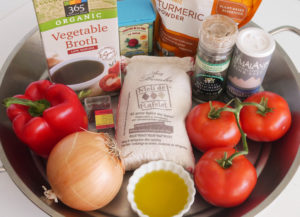
mise en place
As long as you have your mise en place (ingredients and utensils gathered and ready to go before you start cooking), making paella should be a breeze.
Steps
- Heat vegetable broth in a medium saucepan over medium-high heat. Break up saffron and add to the broth. When broth starts to simmer, reduce heat to low just to keep broth hot.
- Heat olive oil in a 12 to 16-inch paella pan (or large wide flat bottomed stainless steel pan…not a non-stick pan). Add onions and red bell peppers and sauté about 5 minutes.
- Add diced tomatoes, smoked paprika and turmeric, cooking for another 1-2 minutes. Turmeric is optional, but we added it because…why not? It’s loaded with health benefits!
- Add a little more oil and the rice. Stir to coat the rice well, cooking for 1 minute to incorporate flavors.
- Slowly pour in the hot broth. Add a little salt and pepper. Gently move the vegetables around so the rice falls evenly to the bottom of the pan as much as possible. Do not stir after this point as stirring will cause the rice to release starches and become creamy. Increase heat to medium-high. When broth comes to a boil, reduce heat to medium or medium-low and cook at a continuous gentle boil, uncovered, for 20 minutes. If using a large paella pan (15 inches or so) you’ll want to rotate the pan over the burner every so often so the rice cooks evenly.
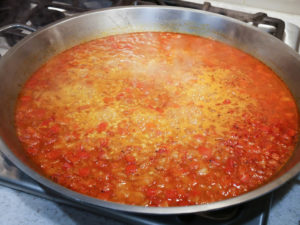
simmered, not stirred
- If you like the socarrat (caramelized layer of toasted rice at the bottom of the pan), at the end of cooking, turn up the heat to medium-high for about 3 minutes, rotating the pan as needed, until you start to hear a snap, crackle, pop and the bottom layer of rice is well browned and crisp.
- Socarrat or not, remove from heat and sprinkle peas (optional) and your favorite roasted veggies over the rice, without mixing them in. Cover with foil and let the paella rest for 5 minutes.
- Garnish with a sprinkle of chopped parsley, if desired and serve with lemon wedges on the side.
Portion onto serving plates or enjoy straight from the pan, as true Valencians do.
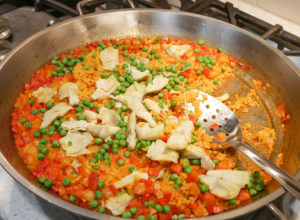
the best batch made with bomba rice
Even though peas are not part of traditional paella, use whatever vegetables you’d like. The above paella is the first batch we made with Bomba rice. You can see we got a nice socarrat, caramelized rice at the bottom of the pan. We added peas and artichoke hearts after the rice was cooked, removed the pan from the heat and covered with foil to let the paella rest for about 5 minutes. Delicious!
A Bit of Trivia
For ultra-authenticity, paella should only be cooked by a man…a Spanish man…and only in Valencia, Spain.
Your Allergy Chefs are participants in the Amazon Associates Program, an affiliate advertising program designed to provide a means for sites to earn advertising fees by advertising and linking to Amazon.
Vegetable Paella
Yield 4-6 Servings
Free of: gluten and top 8 allergens.
A taste of Spain!
Ingredients
Paella
4 cups low-sodium vegetable broth
1/2 tsp saffron threads, crumbled and loosely measured
3 tbsp olive oil, divided (2 tbsp + 1 tbsp)
1 cup diced yellow onion (1 small or medium onion)
3/4 cup diced red bell pepper (1 medium pepper)
1 cup diced tomato
1 tsp smoked paprika
1/2 tsp turmeric powder
1-1/2 cups short-grain paella rice, such as Bomba (see recipe notes)
1 tsp sea salt
1/8 tsp black pepper
3/4 cup frozen peas, thawed (optional)
Roasted Vegetables
1 cup diced carrots
1-1/2 tsp olive oil, divided
1/4 tsp sea salt, divided
8 oz button or cremini mushrooms, trimmed and quartered
1-1/2 cups zucchini, cut in half lengthwise and then cut crosswise into 1/2-inch slices
Garnish
1 tbsp chopped Italian parsley (optional)
Lemon wedges
Instructions
- For the paella, heat vegetable broth in a medium saucepan over medium-high heat. Break up the saffron and add to the broth. When the broth comes to a simmer, reduce heat to low to keep the broth warm.
- Heat the first 2 tablespoons of oil in a 12 to 15-inch Paella pan (or large wide flat bottomed stainless steel pan…not a non-stick pan) over medium heat. Add onions and peppers; sauté until softened and onions are lightly browned, about 5 minutes.
- Add tomatoes, paprika, and turmeric, cooking another 1-2 minutes stirring frequently.
- Add the remaining 1 tablespoon oil and the rice. Stir to coat well, cooking for 1 minute to incorporate flavors.
- Slowly pour in the hot broth. Add the salt and pepper. Gently move the vegetables around so the rice falls evenly to the bottom of the pan as much as possible. Do not stir after this point as stirring will cause the rice to release starches and become creamy. Increase heat to medium-high. When broth comes to a boil, reduce heat to medium or medium-low and cook at a continuous gentle boil, uncovered, for 20 minutes. If using a large paella pan (15 inches or so) you’ll want to rotate the pan over the burner every so often so the rice cooks evenly. We made 2 batches. Our batch with Bomba rice was done in 20 minutes. The batch with "paella rice" from Whole Foods Market took an additional 10 minutes. It was necessary to add about 1/4 cup additional broth to the latter batch.
- For the roasted vegetables, preheat oven to 400-degrees F.
- Line 2 baking pans with parchment paper. In a medium bowl, toss the carrots with ½ teaspoon oil and a dash of salt and arrange in a single layer in the first baking pan.
- Using the same bowl, toss the mushrooms with ½ teaspoon oil and a dash of salt and arrange across half of the second baking pan.
- Toss the zucchini with the remaining ½ teaspoon oil and salt and arrange on the other half of the pan next to the mushrooms.
- Place in the oven and set your timer for 10 minutes. The mushrooms and zucchini will take about 10-15 minutes to roast. Remove the mushrooms and zucchini when they are tender, but not overcooked. Continue to roast the carrots for a total of about 15-20 minutes, removing from oven when crisp tender. Feel free to use whatever vegetables you’d like.
- If you like the socarrat (caramelized layer of toasted rice at the bottom of the pan), at the end of cooking, turn up the heat to medium-high for about 3 minutes, rotating the pan as needed, until you start to hear a snap, crackle, pop and the bottom layer of rice is well browned and crisp.
- Socarrat or not, remove from heat and sprinkle the peas and roasted vegetables over the rice, without mixing them in. Cover with foil and let the paella rest for 5 minutes. Garnish with a sprinkle of chopped parsley, if desired and serve with lemon wedges on the side.
Notes
The short, round grains (Spanish rice) are perfect for paella and absorb liquid really well, which makes it the ideal rice for paella.
Rice varieties that are suitable for paella like Bomba, Senia, and Calasparra are readily available for purchase in Spain. However, if you are in the United States, purchasing these varieties may be difficult since they are usually only available at gourmet and ethnic grocery stores and online. There are some Whole Foods Markets that do sell paella rice from Spain.
You can choose a different short grain rice, but the baking time will vary according to the variety. Calrose rice is readily available in supermarkets and is often substituted for the Spanish varieties. Medium grain or jasmine rice will also work.
Some may say to use arborio rice, however you want the end result to yield separate grains, not a creamy texture like risotto.
Courses Mains